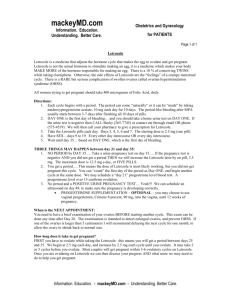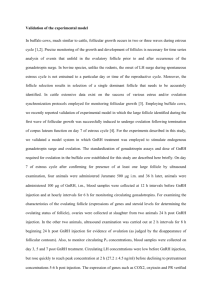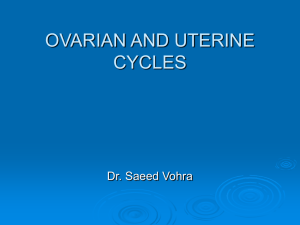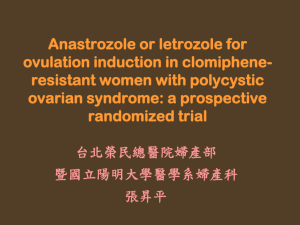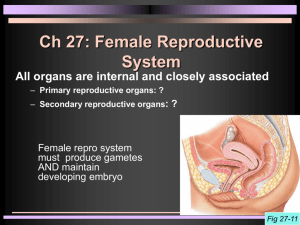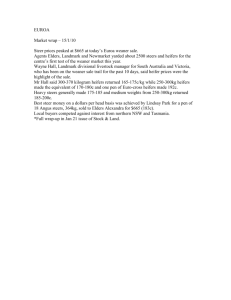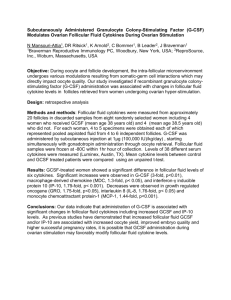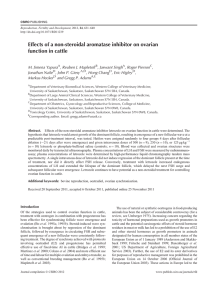A bovine model for examining the effects of an
advertisement
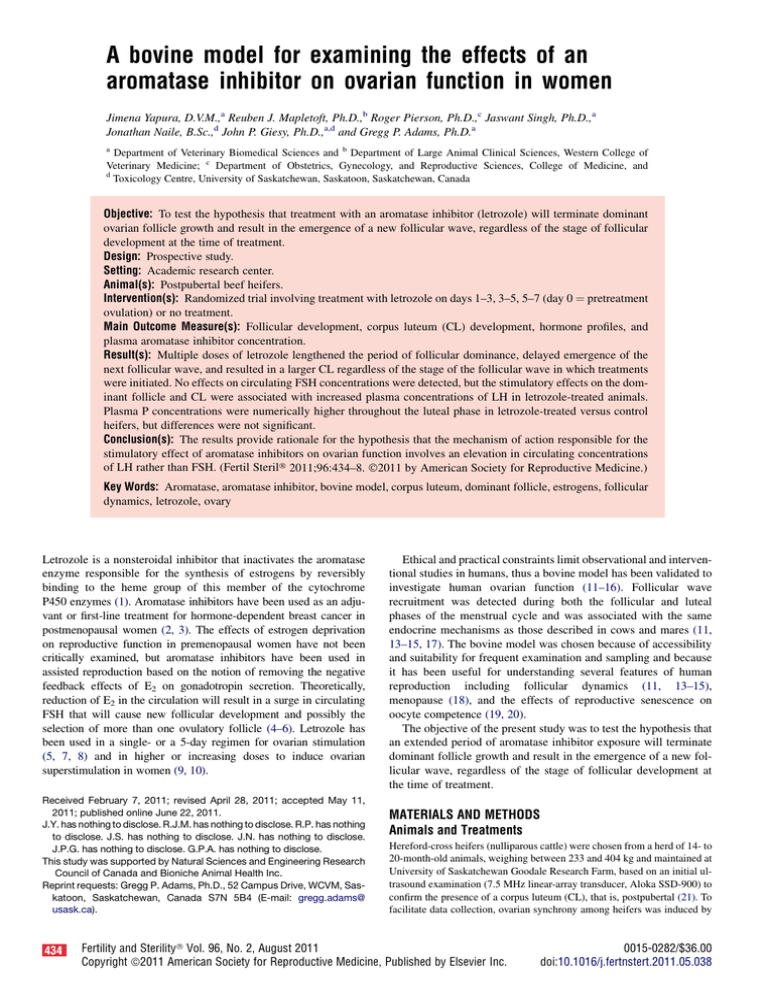
A bovine model for examining the effects of an
aromatase inhibitor on ovarian function in women
Jimena Yapura, D.V.M.,a Reuben J. Mapletoft, Ph.D.,b Roger Pierson, Ph.D.,c Jaswant Singh, Ph.D.,a
Jonathan Naile, B.Sc.,d John P. Giesy, Ph.D.,a,d and Gregg P. Adams, Ph.D.a
a
Department of Veterinary Biomedical Sciences and b Department of Large Animal Clinical Sciences, Western College of
Veterinary Medicine; c Department of Obstetrics, Gynecology, and Reproductive Sciences, College of Medicine, and
d
Toxicology Centre, University of Saskatchewan, Saskatoon, Saskatchewan, Canada
Objective: To test the hypothesis that treatment with an aromatase inhibitor (letrozole) will terminate dominant
ovarian follicle growth and result in the emergence of a new follicular wave, regardless of the stage of follicular
development at the time of treatment.
Design: Prospective study.
Setting: Academic research center.
Animal(s): Postpubertal beef heifers.
Intervention(s): Randomized trial involving treatment with letrozole on days 1–3, 3–5, 5–7 (day 0 ¼ pretreatment
ovulation) or no treatment.
Main Outcome Measure(s): Follicular development, corpus luteum (CL) development, hormone profiles, and
plasma aromatase inhibitor concentration.
Result(s): Multiple doses of letrozole lengthened the period of follicular dominance, delayed emergence of the
next follicular wave, and resulted in a larger CL regardless of the stage of the follicular wave in which treatments
were initiated. No effects on circulating FSH concentrations were detected, but the stimulatory effects on the dominant follicle and CL were associated with increased plasma concentrations of LH in letrozole-treated animals.
Plasma P concentrations were numerically higher throughout the luteal phase in letrozole-treated versus control
heifers, but differences were not significant.
Conclusion(s): The results provide rationale for the hypothesis that the mechanism of action responsible for the
stimulatory effect of aromatase inhibitors on ovarian function involves an elevation in circulating concentrations
of LH rather than FSH. (Fertil Steril 2011;96:434–8. 2011 by American Society for Reproductive Medicine.)
Key Words: Aromatase, aromatase inhibitor, bovine model, corpus luteum, dominant follicle, estrogens, follicular
dynamics, letrozole, ovary
Letrozole is a nonsteroidal inhibitor that inactivates the aromatase
enzyme responsible for the synthesis of estrogens by reversibly
binding to the heme group of this member of the cytochrome
P450 enzymes (1). Aromatase inhibitors have been used as an adjuvant or first-line treatment for hormone-dependent breast cancer in
postmenopausal women (2, 3). The effects of estrogen deprivation
on reproductive function in premenopausal women have not been
critically examined, but aromatase inhibitors have been used in
assisted reproduction based on the notion of removing the negative
feedback effects of E2 on gonadotropin secretion. Theoretically,
reduction of E2 in the circulation will result in a surge in circulating
FSH that will cause new follicular development and possibly the
selection of more than one ovulatory follicle (4–6). Letrozole has
been used in a single- or a 5-day regimen for ovarian stimulation
(5, 7, 8) and in higher or increasing doses to induce ovarian
superstimulation in women (9, 10).
Received February 7, 2011; revised April 28, 2011; accepted May 11,
2011; published online June 22, 2011.
J.Y. has nothing to disclose. R.J.M. has nothing to disclose. R.P. has nothing
to disclose. J.S. has nothing to disclose. J.N. has nothing to disclose.
J.P.G. has nothing to disclose. G.P.A. has nothing to disclose.
This study was supported by Natural Sciences and Engineering Research
Council of Canada and Bioniche Animal Health Inc.
Reprint requests: Gregg P. Adams, Ph.D., 52 Campus Drive, WCVM, Saskatoon, Saskatchewan, Canada S7N 5B4 (E-mail: gregg.adams@
usask.ca).
434
Ethical and practical constraints limit observational and interventional studies in humans, thus a bovine model has been validated to
investigate human ovarian function (11–16). Follicular wave
recruitment was detected during both the follicular and luteal
phases of the menstrual cycle and was associated with the same
endocrine mechanisms as those described in cows and mares (11,
13–15, 17). The bovine model was chosen because of accessibility
and suitability for frequent examination and sampling and because
it has been useful for understanding several features of human
reproduction including follicular dynamics (11, 13–15),
menopause (18), and the effects of reproductive senescence on
oocyte competence (19, 20).
The objective of the present study was to test the hypothesis that
an extended period of aromatase inhibitor exposure will terminate
dominant follicle growth and result in the emergence of a new follicular wave, regardless of the stage of follicular development at
the time of treatment.
MATERIALS AND METHODS
Animals and Treatments
Hereford-cross heifers (nulliparous cattle) were chosen from a herd of 14- to
20-month-old animals, weighing between 233 and 404 kg and maintained at
University of Saskatchewan Goodale Research Farm, based on an initial ultrasound examination (7.5 MHz linear-array transducer, Aloka SSD-900) to
confirm the presence of a corpus luteum (CL), that is, postpubertal (21). To
facilitate data collection, ovarian synchrony among heifers was induced by
Fertility and Sterility Vol. 96, No. 2, August 2011
Copyright ª2011 American Society for Reproductive Medicine, Published by Elsevier Inc.
0015-0282/$36.00
doi:10.1016/j.fertnstert.2011.05.038
transvaginal ultrasound-guided follicular ablation of the two largest ovarian
follicles (22, 23). Three days after the expected emergence of the dominant
follicle (i.e., 4 days after follicular ablation), heifers were given 500 mg of
cloprostenol (PGF, Estrumate, Schering-Plough Animal Health) IM to
induce regression of the CL and synchronize ovulation (24).
The experiment was performed in two replicates (n ¼ 20–27 heifers per
replicate), and each heifer was used only once. In replicate 1, heifers were
assigned randomly at the time of ovulation (day 0) to the following groups
and given a 3-day regimen of letrozole on days 1–3 (n ¼ 5), days 3–5 (n ¼
5), days 5–7 (n ¼ 5), or no treatment (control group, n ¼ 5). In replicate 2,
heifers were similarly assigned to groups and given letrozole from days 1
to 3, (n ¼ 5), days 3 to 5 (n ¼ 4), or days 5 to 7 (n ¼ 4), but untreated control
heifers were arranged in three subgroups to serve as contemporaneous controls for each aromatase inhibitor group (i.e., control days 1–3, n ¼ 4; control
days 3–5, n ¼ 4; and control days 5–7, n ¼ 5). For practical purposes, the total
dose of letrozole (250 mg/kg) was calculated on the basis of an average
weight of 350 kg for all heifers. Hence, a total dose of 87.5 mg was given
to each heifer, divided into three daily doses (29.2 mg per day) and administered IV. Letrozole was prepared in 95% ethanol to a final concentration of
5 mg/mL, resulting in an injection volume of z6 mL/day.
Animal procedures were performed in accordance with the Canadian
Council on Animal Care and were approved by the University of Saskatchewan Protocol Review Committee.
Ovarian Ultrasound
Ultrasound examinations were recorded on a sketch sheet in which each
ovary and its structures (CL and follicles R4 mm in diameter) were represented by size and relative location (25, 26).
Ovulation was defined as the disappearance of a follicle R8 mm between
consecutive daily examinations and was confirmed by the subsequent development of a CL (12). The dominant follicle of a wave was defined as the one
that reached the largest diameter, and a subordinate follicle was defined as
one that appeared to originate from the same follicular pool as the dominant
follicle (25). Follicular wave emergence was defined retrospectively as the
day when the follicle that was destined to become dominant was first identified at a diameter of 4 or 5 mm (27, 28). If the dominant follicle was not
identified until it reached 6 or 7 mm, the previous day was considered the
day of follicular wave emergence (29). The manifestation of selection of
the dominant follicle of a wave was defined as the time of divergence in
the growth profiles of the dominant versus subordinate follicles of the
wave (27, 30). The day of onset of follicular and luteal regression was
defined as the first day of an apparent progressive decrease in follicular
and luteal diameters, respectively (27).
Collection of Blood Samples
Blood samples were collected daily from pretreatment ovulation to posttreatment ovulation by jugular or coccygeal venipuncture into 10 mL heparinized vacuum tubes (Vacutainer tubes; Becton Dickinson Vacutainer Systems).
Additional samples were collected from aromatase inhibitor–treated heifers every 12 hours from the beginning of treatment to the next wave emergence.
Blood samples were centrifuged at 1500 g for 20 minutes, and plasma
was separated and stored in plastic tubes at 20 C.
Hormone Assays
Please refer to the Supplemental Material for details on hormone assays.
Plasma Letrozole Concentration
Plasma concentrations of letrozole were determined from samples collected
every 12 hours from pretreatment to 1 day after cessation of treatment using
high-performance liquid chromatography tandem mass spectrometry (LC/
MS/MS; Supplemental Material).
Statistical Analyses
Serial data were compared among groups by analysis of variance for repeated
measures using the Mixed Procedures of SAS (Statistical Analysis System
Fertility and Sterility
Institute Inc.) to determine the effects of treatment, time, and treatmentby-time interaction. Initial inspection of LH data revealed an apparent difference between morning (when letrozole treatment was applied) and afternoon
values (12 hours after letrozole treatment), and therefore LH data were examined by analysis of variance for repeated measures to determine the main effects of treatment (during and after treatment), stage of follicular
development (days 1–3, days 3–5, and days 5–7), time of the day (A.M. vs.
P.M.), and day of treatment (first, second, and third dose). Since P.M. samples
were not obtained from control animals, the control group was not included
in the analysis. Single-point measurements were analyzed by analysis of variance. If no differences were detected among aromatase inhibitor–treated
groups, data were combined and reanalyzed as a single aromatase inhibitor
treatment group for comparison with nontreated controls. If significant
main effects or interactions (P%.05) were detected, Tukey’s post hoc test
was used for multiple comparisons.
Due to individual variability in circulating hormone concentrations, and
because our objective was to determine the effect of treatment within individuals, LH and FSH concentrations were transformed to a percentage of the
mean concentration of the two first data points collected (days 0 and 1,
day 0 ¼ treatment) for each individual heifer before statistical analysis.
For the same reasons, E2 concentrations were transformed to a percentage
of the mean concentration of two pretreatment data points (i.e., for each individual heifer) before statistical analysis. Plasma E2 concentrations for each
treatment group were compared independently with the respective control
subgroup for each treatment period (data from replicate 2).
RESULTS
Circulating Concentrations of Letrozole
Plasma letrozole concentrations in all three treatment groups were
elevated by 12 hours after initiation of treatment and reached a maximum at 60 hours, followed by a decline to approximately half peak
values by 108 hours (time effect, P<.001). Heifers treated from days
1 to 3 had greater circulating letrozole concentrations than those
treated from days 3 to 5, while those treated from days 5 to 7
were intermediate (overall means, 68.6 4.79, 43.9 4.75, and
55.6 4.75 ng/mL, respectively; P<.01).
Ovarian Follicles and E2
The diameter profiles of the extant dominant follicle (i.e., the dominant follicle present at the time of treatment) were similar among aromatase inhibitor treatment groups; hence, data were combined for
comparison with controls. Compared with controls, the dominant
follicle grew to a greater diameter (P<.01) and the interwave interval
was longer (P<.05) in letrozole-treated heifers (Fig. 1; Table 1).
However, the interovulatory interval did not differ between groups.
The diameter profile of the largest subordinate follicle in heifers
treated with letrozole from days 1 to 3 was larger than that of control
heifers (P<.05; Fig. 2). The diameter profile of the largest subordinate follicle in heifers treated with letrozole from days 3 to 5 was not
different from that of the control group (Fig. 2). As expected, the
largest subordinate follicle had already regressed in heifers treated
from day 5 to 7, and therefore no data were available for analysis.
No differences were detected in plasma E2 concentration between
letrozole-treated and control heifers (no main effects of treatment or
time no an interaction).
CL and Plasma P
No differences in CL diameter or P concentration were detected
among letrozole-treated groups; hence, data for the three treatment
groups were combined for comparison with untreated controls. The
day-to-day CL diameter profile of heifers treated with letrozole was
larger than that of controls (P<.004; Supplemental Fig. 1). Differences in plasma P concentrations were not significant, despite that
435
TABLE 1
Effects (mean ± SEM) of a 3-day regimen of letrozole given at three different stages of the follicular wave in heifers on the intervals
between new wave emergence and ovulation.
Letrozole treatment
Interwave interval, days
Interovulatory interval, days
Dominant follicle diameter at
treatment, mm*
Days 1–3 (n [ 10)
Days 3–5 (n [ 9)
Days 5–7 (n [ 9)
Control (n [ 17)
8.9 0.35a
20.9 0.46a
6.8 0.36a
10.0 0.37a,b
20.1 0.49a
10.1 0.45b,c
10.7 0.37b
21.2 0.49a
12.1 0.43d
7.6 0.27c
20.5 0.35a
6.5 0.27 (day 1),a 9.4 0.32
(day 3),b 11.2 0.30 (day 5)c,d
a,b,c,d
Within rows, values with no common superscript are different (P< .05).
* Compared with respective controls at the same stage of follicular development.
Yapura. Effects of AI on ovarian dynamics in cattle. Fertil Steril 2011.
values were numerically higher throughout the sampling period in the
letrozole-treated groups than in the control group (Supplemental
Fig. 1).
Gonadotropins
No differences were detected in plasma FSH concentration between
letrozole-treated heifers compared with their respective controls,
nor were there any treatment-by-time interactions (Supplemental
Fig. 2). No differences in plasma LH concentrations were detected
among groups using daily samples (P¼.78). The overall model revealed no significant effect or interaction involving follicular stage;
hence, the effect of follicular stage was removed from the model before further analysis. Interactions between day (first, second, and
third) and time (A.M. vs. P.M.) and between treatment period (during
vs. after treatment) and time (A.M. vs. P.M.) were significant. Concentrations of LH were significantly greater in the P.M. samples (12
hours after letrozole treatment) collected during the period of treatment (188% 28.5%) than in the A.M. samples (24 hours after letrozole treatment) collected during the period of treatment (94% 14.9%) or in A.M. and P.M. samples collected after cessation of treatment (79% 14.6% and 79% 27.9%, respectively; Fig. 3).
letrozole on day 3 postovulation in heifers did not induce follicular
atresia or hasten emergence of a new follicular wave (35). Surprisingly, letrozole treatment did not induce an elevation in circulating
FSH concentrations, despite the fact that circulating concentrations
of E2 were affected. Rather, letrozole treatment increased mean
plasma LH concentrations and resulted in a prolonged period of
dominance of the extant dominant follicle and delayed emergence
of the next follicular wave (35).
Continued growth of the dominant follicle and CL in aromatase
inhibitor–treated heifers in the present study was attributed to the effect of increased circulating concentrations of LH (36). A biphasic
pattern of LH secretion was observed in the three aromatase inhibitor–treated groups as a result of an elevation in LH concentration by
12 hours after treatment followed by a decline to baseline within 24
hours. That the evening increase in circulating LH concentration observed in the present study was not a result of natural diurnal variation (37–39) was verified by the observation that the effect was seen
only during the period of letrozole treatment and not after.
DISCUSSION
We hypothesized that a 3-day treatment regimen of aromatase inhibitor would, as a consequence of decreasing E2 production, induce
a surge in circulating FSH and hasten the emergence of a new follicular wave in cattle, regardless of the stage of development of the
dominant follicle at the time of treatment. However, results of the
present study do not support this hypothesis. On the contrary, letrozole treatment caused the extant dominant follicle to grow larger and
prolonged its period of dominance, extending the interval to emergence of the next follicular wave regardless of whether treatment
was initiated before, during, or after selection of the dominant follicle. In women, treatment with letrozole from days 3 to 7 after the
beginning of menses was reported to cause emergence of a new
wave of follicular development shortly after the initiation of treatment (5). The mechanism responsible for this effect was hypothesized to involve removal of the negative feedback effect of E2 on
pituitary FSH secretion, resulting in an endogenous surge in plasma
FSH which, in turn, causes recruitment of a new cohort of growing
follicles (4–6). However, the present study challenges this proposed
mechanism of action.
The results of the present study are consistent with those previously reported in which treatment with single intravenous dose of
436
Yapura et al.
Effects of AI on ovarian dynamics in cattle
FIGURE 1
Diameter profile (mean SEM) of the dominant follicle in heifers
treated with letrozole on days 1–3, 3–5, or 5–7 (day 0 ¼ ovulation;
treatment groups combined, n ¼ 28) compared with untreated
controls (n ¼ 17).
Yapura. Effects of AI on ovarian dynamics in cattle. Fertil Steril 2011.
Vol. 96, No. 2, August 2011
FIGURE 2
FIGURE 3
Diameter profile (mean SEM) of the largest subordinate follicle in
heifers treated with letrozole on days 1–3 (n ¼ 10) or days 3–5 (n ¼
9), compared with untreated controls (n ¼ 17). Heifers treated with
letrozole from days 5 to 7 were not included in the analysis since
the largest subordinate follicle was no longer detectable at
initiation of treatment on day 5. a,b,cOverall means for treatment
groups with no common superscript were different (P< .05).
Effect of letrozole on plasma LH concentrations (expressed as
a percent of the mean of days 0 and 1 postovulation; mean SEM)
in heifers treated in the morning for 3 consecutive days (aromatase
inhibitor groups combined, n ¼ 28) during the 3 days of treatment
and during the 3 days after treatment.
Yapura. Effects of AI on ovarian dynamics in cattle. Fertil Steril 2011.
Yapura. Effects of AI on ovarian dynamics in cattle. Fertil Steril 2011.
The largest subordinate follicle in heifers treated with letrozole from
days 1 to 3 after ovulation grew larger and for a longer period of time
compared with controls. This observation resembled an FSHdependent superstimulatory effect (27, 40); however, it was not
associated with an increase in circulating concentrations of FSH.
Elevated LH may have been responsible for the continued growth of
subordinate follicles during treatment on days 1–3. As the switch
from FSH to LH responsiveness is not a all-or-nothing event, it is plausible that the growing subordinate follicles become responsive to LH
before selection is complete (e.g., day 2 of the follicular wave) (30, 41).
Higher circulating letrozole concentrations in heifers treated
from days 1 to 3 compared with those treated from days 3 to 5
may be attributed to a greater proportion of binding to aromatase
in the latter. Follicular E2 production, and hence aromatase activity,
is low during the first few days after follicular wave emergence but
increases to maximum levels between days 3 and 5 (42).
The bovine model used in the present study served as a tool to
better understand the effect of aromatase inhibitors on ovarian function in women. Results using the bovine model are consistent with
observations reported in a prospective study conducted in premenopausal women (43) in which letrozole treatment on days 5–7 after
menses was associated with elevated LH concentrations and mild
ovarian superstimulation. Results are also consistent with those of
a preliminary report in which treatment of premenopausal women
with a single dose of letrozole at different stages of follicle development failed to recruit a new follicular wave (44). Results of the present study, taken together with those involving treatment of
premenopausal women, provide a rationale for the hypothesis that
the mechanism of action responsible for the stimulatory effect of aromatase inhibitors on ovarian function involves an elevation in circulating concentrations of LH rather than FSH. A test of this
hypothesis and exploration of treatment possibilities using aromatase inhibitors deserves further attention, including verification of
dose-related effects.
Acknowledgments: We thank Dr. Al Chicoine for help in interpreting plasma
letrozole concentrations and Eric Higley and Dr. Hong Chang for help in
measuring E2 concentrations. We also thank the staff at Goodale Research
Farm for assistance with handling the cattle and our summer students
Cody Creelman, Rand Davis, and Druvtej Ambati for help with data
collection.
REFERENCES
1. Bhatnagar A. The discovery and mechanism of action of letrozole. Breast Cancer Res Treat
2007;105:7–17.
2. US Food and Drug Administration 2007. Drug
approval package: Femara (letrozole) tablets.
Available at www.fda.gov/cder/foi/nda/2001/20726S006_Femara.htm.
3. Cohen MH, Johnson JR, Li N, Chen G, Pazdur R. Approval summary: letrozole in the treatment of postmenopausal women with advanced breast cancer.
Clin Cancer Res 2002;8:665–9.
Fertility and Sterility
4. Requena A, Herrero J, Landeras J, Navarro E,
Neyro JL, Salvador C, et al. Use of letrozole in assisted reproduction: a systematic review and meta-analysis. Hum Reprod Update 2008;14:571–82.
5. Mitwally MF, Casper RF. Aromatase inhibition for
ovarian stimulation: future avenues for infertility management. Curr Opin Obstet Gynecol 2002;14:255–63.
6. Mitwally MF, Casper RF. Use of aromatase inhibitor
for induction of ovulation in patients with an inadequate response to clomiphene citrate. Fertil Steril
2001;75:305–9.
7. Mitwally MFM, Casper RF. Single-dose administration of an aromatase inhibitor for ovarian stimulation.
Fertil Steril 2005;83:229–31.
8. Fisher SA, Reid RL, Van Vugt DA, Casper RF. A randomized double-blind comparison of the effects of
clomiphene citrate and the aromatase inhibitor letrozole on ovulatory function in normal women. Fertil
Steril 2002;78:280–5.
9. Al-Fadhli R, Sylvestre C, Buckett W, Tan SL, Tulandi T.
A randomized trial of superovulation with two different
doses of letrozole. Fertil Steril 2006;85:161–4.
437
10. Mitwally MF, Said T, Galal A, Chan S, Cohen M,
Casper RF, et al. Letrozole step-up protocol: a successful superovulation protocol. Fertil Steril
2008;89:S23–4.
11. Adams GP, Pierson RA. Bovine model for study of
ovarian follicular dynamics in humans. Theriogenology 1995;43:113–20.
12. Baerwald A, Adams G, Pierson R. Characterization
of ovarian follicular wave dynamics in women. Biol
Reprod 2003;69:1023–31.
13. Baerwald AR, Adams GP, Pierson RA. A new model
for ovarian follicular development during the human
menstrual cycle. Fertil Steril 2003;80:116–22.
14. Ginther OJ, Beg MA, Bergfelt DR, Donadeu FX,
Kot K. Follicle selection in monovular species. Biol
Reprod 2001;65:639–47.
15. Ginther OJ, Beg MA, Donadeu FX, Bergfelt DR.
Mechanism of follicle deviation in monovular farm
species. Anim Reprod Sci 2003;78:239–57.
16. Mihm M, Evans ACO. Mechanisms for dominant follicle selection in monovulatory species: a comparison
of morphological, endocrine and intraovarian events
in cows, mares and women. Reprod Domest Anim
2008;43:48–56.
17. Adams GP. Comparative pattern of follicle development and selection in ruminants. J Reprod Fert
1999;54:17–32.
18. Malhi PS, Adams GP, Singh J. Bovine model for the
study of reproductive aging in women: Follicular, luteal, and endocrine characteristics. Biol Reprod
2005;73:45–53.
19. Malhi PS, Adams GP, Mapletoft RJ, Singh J. Oocyte
developmental competence in a bovine model of reproductive aging. Reproduction 2007;134:233–9.
20. Malhi PS, Adams GP, Pierson RA, Singh J. Bovine
model of reproductive aging: response to ovarian synchronization and superstimulation. Theriogenology
2006;66:1257–66.
21. Pierson RA, Ginther OJ. Reliability of diagnostic ultrasonography for identification and measurement of
follicles and detecting the corpus luteum in heifers.
Theriogenology 1987;28:929–36.
22. Berfelt DR, Lightfoot KC, Adams GP. Ovarian synchronization following ultrasound-guided transvaginal follicle ablation in heifers. Theriogenology
1994;42:895–907.
438
Yapura et al.
23. Baracaldo MI, Martinez MF, Adams GP,
Mapletoft RJ. Superovulatory response following
transvaginal follicle ablation in cattle. Theriogenology 2000;53:1239–50.
24. Hafs HD, Louis TM, Noden PA, Oxender WD. Control of the estrous cycle with prostaglandin F2{alpha}
in cattle and horses. J Anim Sci 1974;38:10–21.
25. Knopf L, Kastelic JP, Schallenberger E, Ginther OJ.
Ovarian follicular dynamics in heifers: test of twowave hypothesis by ultrasonically monitoring individual follicles. Domest Anim Endocrinol 1989;6:111–9.
26. Ginther OJ, Knopf L, Kastelic JP. Temporal associations among ovarian events in cattle during oestrous
cycles with two and three follicular waves. J Reprod
Fertil 1989;87:223–30.
27. Adams P, Kot K, Smith C, Ginther O. Selection of
a dominant follicle and suppression of follicular
growth in heifers. Anim Reprod Sci 1993;30:259–71.
28. Ginther OJ, Kot K, Kulick LJ, Wiltbank MC. Emergence and deviation of follicles during the development of follicular waves in cattle. Theriogenology
1997;48:75–87.
29. Kastelic JP, Knopf L, Ginther OJ. Effect of day of
prostaglandin F2[alpha] treatment on selection and
development of the ovulatory follicle in heifers.
Anim Reprod Sci 1990;23:169–80.
30. Adams G, Kot K, Smith CA, Ginther OJ. Effect of the
dominant follicle on regression of its subordinates in
heifers. Can J Anim Sci 1993;73:267–75.
31. Evans ACO, Adams GP, Rawlings NC. Endocrine and
ovarian follicular changes leading up to the first ovulation in prepubertal heifers. J Reprod Fertil
1994;100:187–94.
32. Rawlings NC, Jeffcoate IA, Rieger DL. The influence
of estradiol-17[beta] and progesterone on peripheral
serum concentrations of luteinizing hormone and follicle stimulating hormone in the ovariectomized ewe.
Theriogenology 1984;22:473–88.
33. Valentini F, Compagnoneb D, Gentilic A,
Palleschia G. An electrochemical ELISA procedure
for the screening of 17-estradiol in urban waste waters. Analyst 2002;127:1333–7.
34. Hecker M, Park J-W, Murphy MB, Jones PD,
Solomon KR, Van Der Kraak G, et al. Effects of atrazine on CYP19 gene expression and aromatase activ-
Effects of AI on ovarian dynamics in cattle
35.
36.
37.
38.
39.
40.
41.
42.
43.
44.
ity in testes and on plasma sex steroid concentrations
of male african clawed frogs (Xenopus laevis). Toxicol Sci 2005;86:273–80.
Yapura MJ, Mapletoft RJ, Singh J, Pierson RA,
Adams GP. Effects of a single dose of a nonsteroidal
aromatase inhibitor on ovarian function in cattle. Reprod Fertil Devel 2009;22:271.
Taft R, Ahmad N, Inskeep EK. Exogenous pulses of
luteinizing hormone cause persistence of the largest
bovine ovarian follicle. J Anim Sci 1996;74:2985–91.
Gombe S, Hall WC, McEntee K, Hansel W,
Pickett BW. Regulation of blood levels of LH in bulls:
influence of age, breed, sexual stimulation and temporal fluctuations. J Reprod Fertil 1973;35:493–503.
Ji WZ, Kaynard AH, Pau KY, Hess DL,
Baughman WL, Spies HG. Endogenous opiates regulate the nocturnal reduction in luteinizing hormone
pulse frequency during the luteal phase of the macaque
menstrual cycle. Biol Reprod 1989;41:1024–33.
Wilks JW, Hansel W. Oxytocin and the secretion of
luteinizing hormone in cattle. J Anim Sci
1971;33:1048–52.
Nasser LF, Adams GP, Bo GA, Mapletoft RJ.
Ovarian superstimulatory response relative to follicular wave emergence in heifers. Theriogenology
1993;40:713–24.
Bodensteiner KJ, Wiltbank MC, Bergfelt DR,
Ginther OJ. Alterations in follicular estradiol and
gonadotropin receptors during development of
bovine
antral
follicles.
Theriogenology
1996;45:499–512.
Singh J, Pierson RA, Adams GP. Ultrasound image attributes of bovine ovarian follicles and endocrine and
functional correlates. J Reprod Fertil 1998:19–29.
Cortınez A, De Carvalho I, Vantman D, Gabler F,
I~niguez G, Vega M. Hormonal profile and endometrial morphology in letrozole-controlled ovarian hyperstimulation in ovulatory infertile patients. Fertil
Steril 2005;83:110–5.
Allaway H, Chizen D, Adams GP, Pierson RA. A single 20 mg dose of aromatase inhibitor (AI) does not
affect folliculogenesis in the follicular phase of the
menstrual cycle. In: 56th Annual Meeting of the Canadian Fertility and Andrology Society. Vancouver,
British Columbia, Canada, 2010:41.
Vol. 96, No. 2, August 2011
SUPPLEMENTAL MATERIAL
Hormone Assays
Plasma LH concentrations were determined in duplicate using a doubleantibody radioimmunoassay (NIDDK-bLH4) (31, 32). The minimum and
maximum values along the standard curve were 0.06 and 8 ng/mL,
respectively. The intra- and interassay coefficients of variation were 7.9%
and 2.5%, respectively, for low reference samples (mean, 0.85 ng/mL) and
8.6% and 9.5%, respectively, for high reference samples (mean, 2.5 ng/mL).
Plasma FSH concentrations were determined in duplicate using a doubleantibody radioimmunoassay using NIDDK-anti-oFSH-1 primary antibody
and expressed as United States Department of Agriculture bovine FSH-Il
units (31, 32). The minimum and maximum values along the standard
curve were 0.12 and 16 ng/mL, respectively. The intra- and interassay
coefficients of variation were 11.1% and 11.2%, respectively, for low
reference samples (mean, 1.9 ng/mL) and 5.2% and 4.1%, respectively, for
high reference samples (mean, 4.0 ng/mL).
Plasma E2 concentrations were determined in duplicate by enzyme-linked
immunosorbent assay (Cayman Chemical Company). The minimum and
maximum values along the standard curve were 6.6 and 4,000 pg/well, respectively. The intra- and interassay coefficients of variation for reference
samples (100 pg/mL) assayed in duplicate were 11.7% and 12.7%, respectively. A concentration procedure using diethyl ether extraction was performed before the assay in all samples to increase estrogen concentration
to measurable levels (33). A 3H-labeled steroid was added to each plasma
sample before extraction as an internal recovery standard (34).
Plasma P concentrations were determined in duplicate using a commercial
solid-phase kit (Coat-A-Count; Diagnostic Products Corporation). The range
of the standard curve was 0.1–40.0 ng/mL. The intra- and interassay coefficients of variation for samples assayed in duplicates were 10.1% and 15%,
respectively, for low reference samples (mean, 1.8 ng/mL) and 5.5% and
7.7%, respectively, for high reference samples (mean, 17.5 ng/mL).
Fertility and Sterility
Plasma Letrozole Concentration
Plasma concentrations of letrozole were determined using highperformance liquid chromatography tandem mass spectrometry (LC/
MS/MS). Letrozole was extracted from 250 mL of plasma with 250
mL of 0.1 M ammonium acetate followed by the addition of 5 mL of
methyl t-butyl ether and vortexed for 15 seconds. The organic layer
was removed and transferred to a fresh 15-mL plastic tube and dried
by gentle nitrogen gas flow. The dried extract was reconstituted in 1
mL of 100% ethanol, sonicated for 5 minutes, and transferred to a labeled
vial for further analysis. Separation was accomplished by HPLC (Agilent
1200) fitted with an analytical column (50 2.1 mm, 3 mm particle
size; Thermo Scientific Betasil C18) operated at 35 C. Gradient conditions were used at a flow rate of 250 mL/minute, starting at 85% A
(0.1% acetic acid) and 15% B (0.1% acetic acid in acetonitrile). Initial
conditions were held for 2 minutes and then ramped to 100% B at 6
minutes, held until 9 minutes, decreased to 0% B at 11 minutes, returned
to initial conditions at 13 minutes, and held constant until 15 minutes.
Mass spectra were collected using a tandem mass spectrometer (Applied
Bioscience SCIEX 3000) fitted with an electrospray ionization source
that was operated in the negative ionization mode. Chromatograms
were recorded using multiple reaction monitoring mode, where at least
two transitions per analyte were monitored. The following instrument parameters were used: desolvation temperature 450 C, desolvation (curtain)
gas 6.0 arbitrary units (AU), nebulizer gas flow 4 AU, ion spray voltage
4,500 V, collision gas 12 AU, collision energy 46 AU, declustering potential 30 AU, and a dwell time of 100 ms. Quantification using these
transitions was performed using Analyst 1.4.1 software provided by
SCIEX (Applied Bioscience). The minimum and maximum values along
the standard curve were 0.25 and 500 mg/mL, respectively. The limit of
quantification used in this method was 250 ng/mL, and the mean recovery was 70%.
438.e1
SUPPLEMENTAL FIGURE 1
(A) Diameter profile of the corpus luteum and (B) plasma progesterone concentration (mean SEM) in heifers treated with letrozole (85 mg/kg/
day for 3 days; data from treatment periods of Days 1 to 3, 3 to 5, and 5 to 7 combined; n ¼ 18), compared to untreated controls (n ¼ 17).
Yapura. Effects of AI on ovarian dynamics in cattle. Fertil Steril 2011.
438.e2
Yapura et al.
Effects of AI on ovarian dynamics in cattle
Vol. 96, No. 2, August 2011
SUPPLEMENTAL FIGURE 2
Plasma FSH concentration, expressed as a percent of the mean of Days 0 and 1 (mean SEM), in heifers treated with letrozole on Days 1 to 3
(n ¼ 10), Days 3 to 5 (n ¼ 9), or Days 5 to 7 (n ¼ 9; Day 0 ¼ ovulation), compared to untreated controls (n ¼ 17).
Yapura. Effects of AI on ovarian dynamics in cattle. Fertil Steril 2011.
Fertility and Sterility
438.e3

